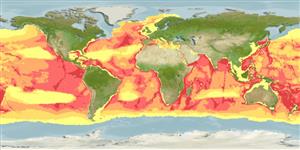Common names from other countries
Environment: milieu / climate zone / depth range / distribution range
Οικολογία
Πελαγικό(ά); ωκεανόδρομο(ς) (Ref. 75906); εύρος βάθους 0 - 2332 m (Ref. 116169). Tropical; 90°N - 90°S, 180°W - 180°E
Atlantic Ocean, Mediterranean and Indo-Pacific. Tropical to warm temperate.
Length at first maturity / Μέγεθος / Βάρος / Age
Maturity: Lm ?, range 366 - 427 cm Max length : 600 cm TL αρσενικό/απροσδιόριστο; (Ref. 1394); 500 cm TL (female); μεγ. δημοσιευμένο βάρος: 2.0 t (Ref. 1394)
Found in shallow inshore (Ref. 122680) and deep offshore waters (Refs. 1394, 118705). Typically in groups of 10 to 60 individuals (Ref. 801). Food sharing is observed in this species, and they travel in a broad band up to several kilometers wide in order to increase success of finding prey (Ref. 122680). Feeds primarily on fish like mahi mahi and yellowfin tuna (Ref. 122680) and cephalopods (Refs. 801, 1394, 118705); was reported to attack small cetaceans and, on one occasion, even a humpback whale (Ref. 1394).
Breeding occurs throughout the year (Ref. 97351).
Tan, J.M.L. 1995. (Ref. 936)
IUCN Red List Status (Ref. 130435)
CITES status (Ref. 108899)
Not Evaluated
Human uses
αλιεία: Εμπορικό(ά)
FAO - αλιεία: landings, species profile | FishSource | Η θάλασσα γύρω μας
Εργαλεία
Διαδικτυακές πηγές
Estimates based on models
Preferred temperature
(Ref.
115969): 2.3 - 5.8, mean 3.4 (based on 3246 cells).
Vulnerability
Very high vulnerability (85 of 100).
Price category
Unknown.
